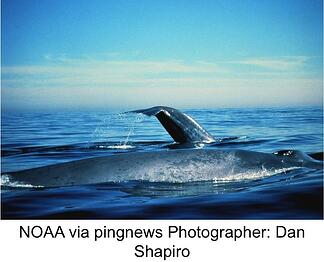Imagine you’re shipping your ocean freight cargo and the carrier vessel transporting your goods crashes into a giant blue whale. This is becoming a common occurrence off the coast of Sri Lanka.
 The blue whale is the largest creature ever known to live on earth. That includes the monstrous dinosaurs that once roamed the planet.
The blue whale is the largest creature ever known to live on earth. That includes the monstrous dinosaurs that once roamed the planet.
Little is known about these giant, endangered creatures; however, one thing that is known is many blue whales have made the waters off the southern coast of Sri Lanka their home. While blue whales are known to migrate over large distances, the ones off the coast of Sri Lanka appear to stay there year round.
Also in those waters, only 15 miles off Sri Lanka’s southern coast, is one of the busiest shipping lanes in the world.
It’s not hard to imagine that where one of the world’s largest whale populations and busiest routes for cargo carriers meet, the two are colliding. While this certainly presents dangers to cargo vessels, their crews, and shippers’ ocean freight, it is the whales that seem to be on the losing end.
A recent New York Times article describes the sight of a dead, 60-foot-long blue whale that was discovered by whale watchers. “The body was swelling rapidly, and suckerfish swarmed across its skin. Even more unsettling was the condition of its tail, which had been nearly severed from the body.”
Another grisly image from the article describes a blue whale “found draped over the bow of a container vessel in the harbor in the capital, Colombo…”
20 whale carcasses were seen last year around the island according to the New York Times article and that could be just the tip of the iceberg. The article goes on to say, “Because blue whales often sink soon after they are struck, most such deaths go unrecorded, and Dr. Calambokidis says the true number ‘could be 10 or 20 times’ the number seen.”
What is being done about this problem? Reading an article on ColomboPage: Sri Lanka Internet Newspaper, it would appear not much.
Moving the shipping lane farther out to sea could help prevent many cargo carriers from colliding with whales, but according to the ColomboPage article, “Sri Lanka Minister of Fisheries Rajitha Senaratne says that the international shipping route off Sri Lanka’s southern coast will not be shifted.”
Sri Lanka’s concern with moving the shipping lane farther out to sea, according to the article, is that it would negatively affect the commercial value of Sri Lanka’s newly built Hambantota harbor.
At the same time, Sri Lanka government is trying to increase tourism, using whale watching as a major draw according the New York Times article mentioned above. The whale watching boats could be driving the whales into the shipping lanes in increasing numbers.
There are no regulations set in place like we have here in the U.S. for keeping a distance from the whales off the coast of Sri Lanka.
But something is being done. Marine biologist Asha de Vos is leading a charge of researching and protecting the blue whales off the coast of Sri Lanka. Hopefully, her work will continue to gain more support which will in the end be good for both the blue whale population off the coast Sri Lanka, Sri Lanka itself, and for the shippers transporting their ocean freight cargo across the shipping lane there.
Take some time to check out Asha de Vos’ blog.
The New York Times has this great video about marine biologist, Asha de Vos studying and trying to save these giant creatures in the waters off Sri Lanka.
And remember, if you have cargo to ship internationally, Universal Cargo Management is always ready to give you a free freight rate quote. We also offer marine shipping insurance to protect you in case your cargo’s carrier vessel hits a blue whale and the cargo is damaged.
